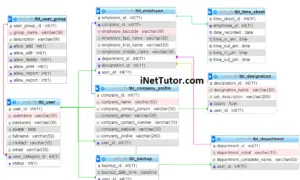Clinic Information System with Decision Support System Related Literature
REVIEW OF RELATED LITERATURE / SYSTEM
Related Literature
Decision Support System “Evolution”
Daniel E. O’Leary
University of Southern California, Los Angeles, California
1. Introduction
Apparently, Courbon, Grajew and Tolovi (1978) were the first to use the notion of “evolution” in decision support systems (DSS). Soon after that, Keen (1980) elaborated on key aspects related to evolution in DSS. That research was most concerned with the notion that DSS evolve over time: the development methodology of DSS is an evolutionary one. In a closely related set of developments, Lehman et al. (1983) appear to have been the first to use the term “evolution” in conjunction with generic computer software. In particular, Lehman (1998) labeled software development and maintenance, as software “evolution.” He described software change and enhancement as “unending,” suggesting that evolution also is unending.
1.1 Scope
DSS as a bundle of hardware, data and knowledge, user interface and software application -change and evolve over time. As a result, the purpose of this paper is to investigate the notion of DSS evolution and DSS characteristics and component evolution. Previous literature has primarily been concerned about the notions that DSS evolve and that methodologies of DSS development consider that evolution. In addition, there has been some concern as to why DSS evolve. However, there has been limited research according to how DSS actually change and evolve over time. Accordingly, we review the previous literature on DSS evolution, according to its individual components and provide specificity for DSS evolution through those components changing over time. In addition, we extend the notion of evolution to a more proactive perspective, aimed at management of evolution, where we try to predict and facilitate evolution as part of DSS management, rather than just passive evolution.

The scope of the paper is to investigate evolution of DSS, in general, and in its components, specifically. For some DSS components there is an extensive evolution literature, for example, database schema. However, for others there is a more limited literature, e.g., evolution of different knowledge representations. Because of the broad reaching and extensive nature of this topic, we provide additional discussion on knowledge evolution, including knowledge artifacts, such as taxonomies.
1.2 This Paper
This chapter proceeds as follows. Section 2 discusses key issues associated with evolution and how it relates to DSS, including such issues as what is DSS evolution, what are some sources of evolution and the extent to which backward compatibility is an important issue in DSS evolution. Section 3 provides a review of some of the previous literature that deals with DSS evolution, analyzing each major component of a DSS for previous discussions on evolution. Section 4 focuses on knowledge evolution, while section 5 drills down on how to manage that knowledge evolution by facilitating and predicting knowledge evolution. Section 6 provides a brief summary of the paper and the contributions.
Review of Related Study
Computerized Clinical Decision Support Systems for Chronic Disease Management: A decision-Maker-Researcher Partnership System
Base to the authors of www.implementationscience.com the use of computerized clinical decision support systems (CCDSSs) may improve chronic disease management, which requires recurrent visits to multiple health professionals, ongoing disease and treatment monitoring, as well as patient behavior modification. The objective of this review was to determine if computerized clinical decision support systems (CCDSSs) improve the processes of chronic care (such as diagnosis, treatment, and monitoring of disease) and associated patient outcomes (such as effects on biomarkers and clinical exacerbations). http://www.implementationscience.com/content/6/1/92
Clinical Decision Support Systems
The Clinical decision support (CDS) systems provide clinicians, staff, patients, and other individuals with knowledge and person-specific information, that are intelligently filtered and presented at appropriate times, to enhance health and health care. The Institute of Medicine has long recognized problems with health care quality in the United States, and for more than a decade has advocated using health information technology (IT), including electronic CDS, to improve quality. According to the author of this site, since 2004, when the Federal Government had promoted the importance of electronic medical records (EMRs), there has been a slow but increasing adoption of health IT. It must be remembered, though, that these health IT applications are a means to improve health care quality, not an end in themselves. Further, although EMRs with computerized provider order entry (CPOE) can improve accessibility and legibility of information, it is unlikely that there will be major improvements in the quality and cost of care from the use of health IT without proper implementation and use of CDS. http://healthit.ahrq.gov/images/jun09cdsreview/09_0069_ef.html
Medical Education and Decision-Support Systems
James B. Lewis Jr., MD, and Kathryn Ryder, MD, MS. March 2011,
According to James B. Lewis Jr. and Kathryn Ryder, only about 55 percent of patients receive evidence-based care. But, if we want to increase the use of evidence-based medicine and raise the quality of care for all patients, the evidence must be at the fingertips of those making clinical decisions. In their ranking of evidence-based resources in terms of their effectiveness as decision-making aids, Strauss and Haynes place original journal articles at the bottom, followed by systematic reviews (Cochrane database), evidence-based journal abstracts (ACP Journal Club), and evidence-based textbooks (ACP PIER, Clinical Evidence); at the top, they argue, should be the computerized decision-support system (CDSS) . Their argument is a practical one. For the practicing physician, evidence-based assistance must be “reliable, relevant, and readable”, and for the physician trainee, a CDSS that succinctly cites the evidence for specific orders has great educational promise. The CDSS also offers the opportunity to move a new therapy from newly published research to standard of care more quickly than the 17 years it currently takes.
http://virtualmentor.ama-assn.org/2011/03/medu1-1103.html
Computerized Clinical Decision Support and Knowledge Management in Community Settings: A Qualitative Study
There is substantial evidence that computerized provider order entry (CPOE) with clinical decision support (CDS) can enhance health care quality and efficiency base on the biometrics.com website. It defines CDS broadly to include “passive and active referential information as well as computer-based order sets, reminders, alerts, and condition or patient-specific data displays that are accessible at the point of car”. Interest in CPOE with CDS is intensifying among clinicians and hospitals in the U.S. as federally funded financial incentives are enacted. At present, only 10 to 20 percent of hospitals have CPOE, the large majority of which are academic hospitals with teaching programs or hospitals with large numbers of employed physicians, such as Veterans Affairs or Kaiser Permanente hospitals. Although 86% of the 5815 hospitals in the U.S. are community hospitals, only 6.9% of them report having even a basic CPOE system. In ambulatory settings, 17% of physicians report that they use clinical information systems, and only 4% of those physicians use systems that include CPOE and CDS. The numbers, however, are rapidly rising.
http://www.biomedcentral.com/1472-6947/12/6
You may visit our Facebook page for more information, inquiries, and comments. Please subscribe also to our YouTube Channel to receive free capstone projects resources and computer programming tutorials.
Hire our team to do the project.

